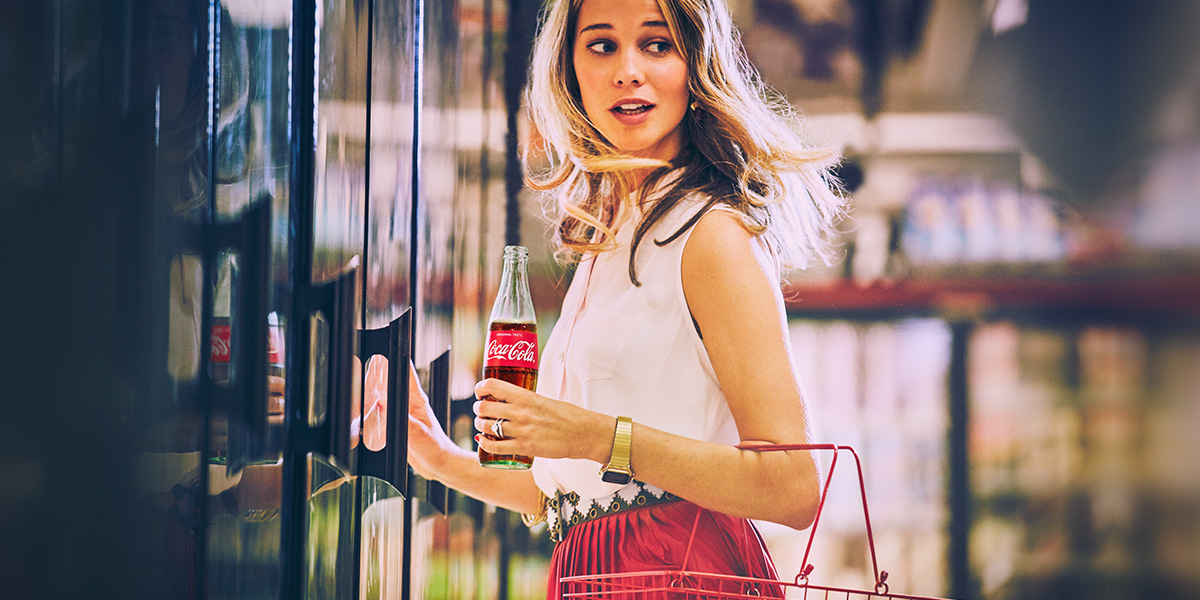
Merchandising the Convenience Retail Zones Helps Convert Shoppers into Buyers
Leverage strategic points of inspiration to boost sales

A typical convenience store that sells gas may attract almost 2,500 people to its lot per day, according to Coca-Cola research.¹ Only 71% of those would-be shoppers will go inside the store, and approximately 40% enter the store, but don’t buy any merchandise.¹ That means every day about 1,800 convenience store visitors leave without purchasing a beverage. These numbers can add up to a $57,000 opportunity.¹ The Coca-Cola Company is committed to helping convenience retail customers realize this opportunity by reaching would-be shoppers with points of inspiration (POI’s) to convert them into buyers.
The Opportunity
The same research also shows that convenience store success requires two types of conversions: lot-to-visit, which is the percentage of people who arrive on the lot and go inside the store; and visit-to-purchase, those who go inside the store and make a purchase.¹ By improving lot-to-visit conversion by just one point, a single convenience store could see as much as $19,000 in incremental total sales, and a bump of $8,200 for the Non Alcoholic Ready-to-Drink (NARTD) category alone.¹ Boosting visit-to-purchase conversion by a single point, results in a nearly double impact, with a $36,000 increase in overall sales and a $15,500 increase in NARTD sales.¹ If convenience stores can do both of these together, they could see a $57,000 total store impact, nearly $25,000 of which would be for the NARTD beverage category.¹
Understanding Traffic Patterns
Of the 1,750 visitors who go inside the convenience store, only about 37% purchase NARTD beverages, which equates to approximately 1,100 potential buyers per outlet every day.¹ Coke’s research highlights not only convenience store transactions, but also shopper traffic, revealing that 26% of shoppers who enter convenience store visit cold vault non-alcoholic beverages first, followed by salty snacks (15%), confections (12%) and dispensed non-alcoholic beverages (10%).¹
“When we think of bundling opportunities, shopper behavior suggests that the in-store ‘real estate’ that’s between first destination categories and the checkout gives us multiple opportunities to drive bigger baskets if we can connect the dots for the shopper,” says Scott Tillman, director, retail channel strategy & commercialization for Coca-Cola. Put another way, of every 100 people who visit convenience store beverage categories, what proportion stops to actually shop and engage? Of those who stop and engage, what proportion actually purchases?
Dispensed beverages (inclusive of fountain and frozen) are #1 for traffic-to-shop conversion, getting 76% of their category traffic to stop and engage, while energy drinks are #1 among cold vault categories at 48%.¹ When it comes to shop-to-buy conversion, dispensed beverages lead the way with 66%, while SSD’s lead among cold vault beverages at 39%.¹
Maximizing the Fountain
Although fountain beverages do not have the same draw as the cold vault, the fountain still ranks fourth of any category and has a high rate of conversion among shoppers.¹ Fountain shoppers are 24% more likely to purchase foodservice items (such as deli items, prepared foods and ready-to-eat foods) than cold vault shoppers, highlighting a natural affinity between fountain and foodservice.¹ Therefore, foodservice promotions and/or bundling makes sense for fountain beverages. “Dispensed NARTD’s do a good job of converting category traffic into shoppers and shoppers into buyers,” says Tillman. “This suggests the category would benefit most via traffic-driving tactics.”
While cold vault beverages draw higher traffic, they get a lower proportion of visitors to shop and buy.¹ However, the high traffic areas between the vault and the register – as well as the vault itself – are fertile ground for priming incremental purchases with NARTD beverages. “This suggests that the vault would benefit most from tactics that increase shopability and engagement,” says Tillman.
Strategies
Tillman recommends convenience stores take an integrated, total store view. “Points of inspiration can work better together to reinforce a much bigger idea to shoppers,” he says.
- Prime and tempt shoppers to enter: Leverage gas island and forecourt real estate to drive lot to visit conversion.
- Create positive disruption in the impulse zone: Even small gains in visit-to-purchase conversion can make an impact.
- Think “vault back” and “fountain back”: 1 in 4 shoppers visit the cold vault before any other category, and the perimeter location of most cold vaults requires shoppers to pass a variety of complementary categories to and from this key first destination.¹ “It’s important to optimizing the cold vault and fountain destinations,” says Tillman. “The draw of the cold vault is an asset for retailers and an opportunity for us to partner to generate more value for them.”
Learn more about strategies for convenience retail by speaking with your Coca-Cola representative today.
Read Related Articles:
Trends in Foodservice Boost Convenience Retail
Boost Premium Water Sales with smartwater® Cooler and Rack
Satisfy Demand for Snacks and Beverages on the Go
Sources:
¹ Coca-Cola Videomining C-store Mega Study (Fall 2014)